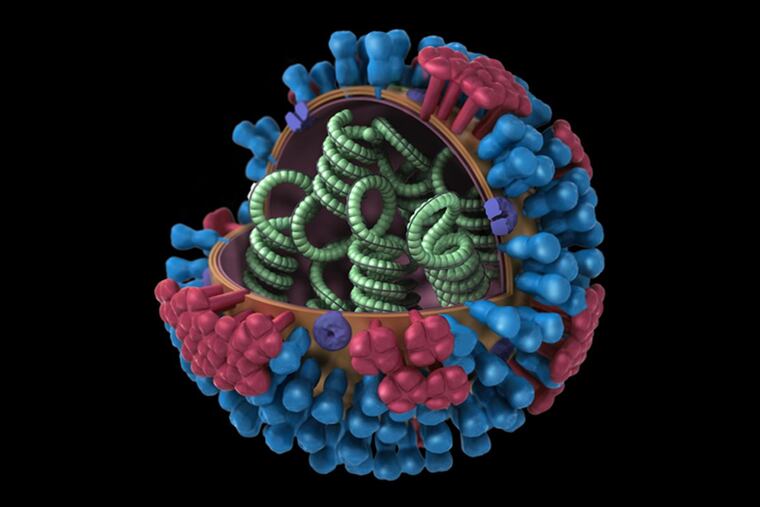Flu cases up sharply in the region; Pa. records 18 more flu deaths
New reports from New Jersey and Pennsylvania both show cases are up. Hospital officials say they're seeing it, too.

Flu is still on the rise in New Jersey and Pennsylvania, according to the latest reports issued by state Health Departments on Wednesday, and hospitals around the region are feeling the strain.
The Pennsylvania report noted a sharp increase in flu activity during the week ending Jan. 27. Tina Tan, state epidemiologist for the New Jersey Department of Health, said flu activity in her state was at "really high levels right now."
Pennsylvania also reported an uptick in deaths. It said that 18 people died of flu last week, bringing the total for the season to 65. That included two children under the age of 18. New Jersey reports only pediatric deaths and still has only one, a previously reported 4-year-old girl who hadn't been vaccinated against flu.
Joseph Bushra, chief of emergency medicine at Lankenau Medical Center, doesn't need the state reports to know flu is in our midst. Patient volume in his emergency department rose from 4,500 in December to 4,900 in January, an increase he attributed to flu cases on top of the usual heart attacks, strokes, and traumas. While some were patients who could have safely gone to a primary-care doctor if they'd been able to get an appointment, many were sick enough to need admission to the hospital. It was the busiest month ever for hospital admissions from the emergency department, he said.
"We're seeing a tremendous increase in patient volume, a significant increase due to flu," Bushra said.
The hospital has coped by increasing staffing and streamlining its triaging process. Medical personnel are wearing masks to protect both themselves and their patients from the virus.
"All hands are on deck, and it's a teamwork thing to get through it," Bushra said.
Mark Ross, southeastern regional manager of emergency preparedness at the Hospital and Healthsystem Association of Pennsylvania, said hospitals expect a spike in patients this time of year and staff accordingly. Generally, hospitals in this region have been able to manage the influx of patients. "We stay ahead of the curve," Ross said.
In New Jersey, Kerry McKean Kelly, vice president of communications and member services for the New Jersey Hospital Association, said hospitals had "extremely busy" emergency departments and high numbers of in-patients. They have been able to "ramp up quickly" to meet the higher demand.
Some hospitals, she added, are restricting visitors to prevent further spread of the virus. Others have placed age limits on children who are visiting or are screening for visitors who show signs of illness.
New Jersey's latest report shows some measures of flu topping the average of its three highest years. Those include the percentage of emergency department visits attributed to influenza-like illness, which was approaching 9 percent, and the percentage of emergency department patients who were hospitalized because of flulike illness, which was slightly above 5 percent. At the same time, reports of school absenteeism due to flu were on the low end and flu cases in long-term care facilities such as nursing homes were not particularly high.
Tan said she did not have the data to say how long it's been since New Jersey has had so much flu. This year, she said, is very similar to the 2012-13 and 2014-15 seasons, where the H3N2 version of flu also was common. H3N2 is known to cause worse symptoms than other strains and is better at evading vaccines. Influenza B, which tends to peak later in the year than A strains like H3N2, now accounts for a growing number of cases.
In Pennsylvania, the number of reported flu cases last week was the highest weekly count since 2003, though flu is not a disease that must be reported, so the state does not learn of all cases. Nate Wardle, a public information officer for the Health Department, said that the state's ability to count flu has improved markedly, particularly since the H1N1 pandemic of 2009.
The percentage of Pennsylvania emergency department patients with flu symptoms also rose, the Pennsylvania report said. It was highest in the southeastern part of the state, where it was above 5 percent. The state does not release precise numbers.
Julia Sammons, medical director of the department of infection control and prevention at Children's Hospital of Philadelphia, said the hospital had seen a sharp increase in flu activity, but not in patients sick enough to stay in the hospital.
She thinks publicity about the flu — this has reportedly been an unusually ugly flu season in some parts of the country — may be behind some of the visits. "Most people with flu will have mild illness and will not need medical care," she said.
People who are either very young or very old, or have other health problems are most at risk for the flu. For the rest of us, resting at home where we won't expose more people is usually the best strategy, Sammons said. You should check with your doctor if you have a high fever for more than two days or have trouble breathing. Parents should be on the lookout for signs of dehydration or lethargy.
As usual, all the experts say it's not too late to get a flu shot. And remember to wash your hands.